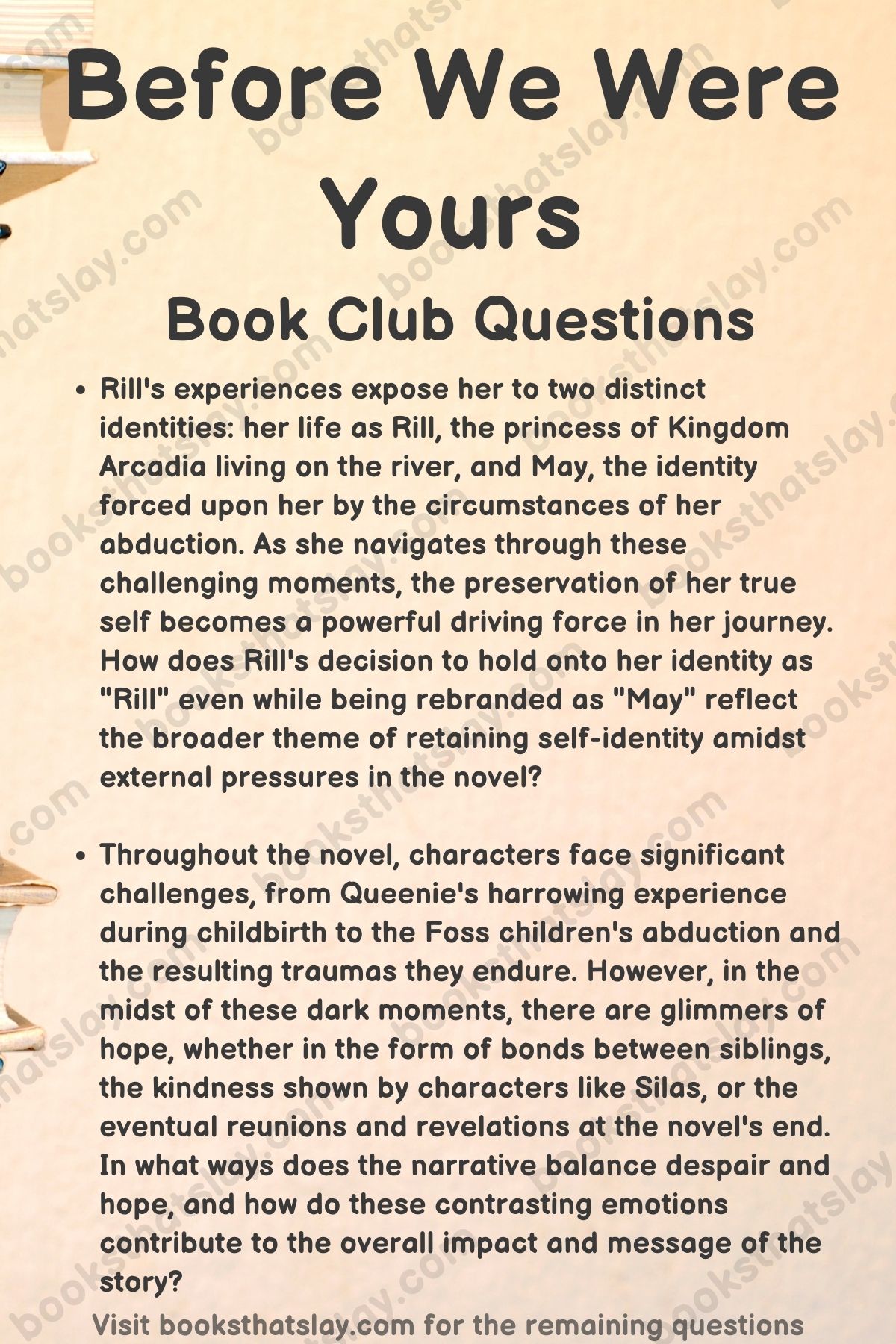10 Before We Were Yours Book Club Questions for Discussion
Lisa Wingate’s “Before We Were Yours” is not just a riveting tale that binds readers with its intricacies, but a poignant exploration of memory, identity, and the profound strength of familial bonds.
While the novel’s storyline captivates with its twists and turns, it’s the undercurrents of emotional and psychological journeys that makes us readers pause and introspect. In today’s post, we’ll delve deeper into the thematic heart of the book, posing some thought-provoking book club questions for Before We Were Yours that uncover the layers of character development, the duality of identity, and the transformative power of relationships.
Whether you’re a first-time reader or revisiting the novel, these questions promise a richer, more nuanced appreciation of Wingate’s masterpiece.
Dive in, and let’s embark on this reflective exploration together.

Before We Were Yours Book Club Questions
- In the novel, the traumatic separation of the Foss siblings and their subsequent journey through a corrupt and abusive adoption system serves as a stark contrast to the familial bonds they once held on the shantyboat. Rill, as the eldest sibling, bears the weight of this separation heavily and tries desperately to protect and reunite her family, even after being given a new identity and life.
How does Wingate explore the themes of resilience, the strength of familial bonds, and the lasting effects of childhood trauma through Rill’s character and her relationship with her siblings? - Rill’s experiences expose her to two distinct identities: her life as Rill, the princess of Kingdom Arcadia living on the river, and May, the identity forced upon her by the circumstances of her abduction. As she navigates through these challenging moments, the preservation of her true self becomes a powerful driving force in her journey.
How does Rill’s decision to hold onto her identity as “Rill” even while being rebranded as “May” reflect the broader theme of retaining self-identity amidst external pressures in the novel? - Avery comes from a privileged background, bearing the weight of societal expectations, whereas Rill’s upbringing on the Mississippi River, amidst financial constraints, portrays a life full of freedom and unity, though marred by vulnerability.
Considering their respective backgrounds, how does the novel address the relative values and disadvantages of wealth and poverty in relation to personal identity and familial relationships? - Throughout the novel, characters face significant challenges, from Queenie’s harrowing experience during childbirth to the Foss children’s abduction and the resulting traumas they endure. However, in the midst of these dark moments, there are glimmers of hope, whether in the form of bonds between siblings, the kindness shown by characters like Silas, or the eventual reunions and revelations at the novel’s end.
In what ways does the narrative balance despair and hope, and how do these contrasting emotions contribute to the overall impact and message of the story? - Throughout the novel, the past intertwines with the present, especially as Avery dives deep into her grandmother’s history, and as Grandma Judy drifts between past and present memories due to her advancing dementia. Memories serve as both a guide and a barrier, revealing hidden truths while also raising more questions.
In light of this, how does the book underline the significance of memory in shaping one’s identity, and how does it highlight the impact of discovering and confronting painful pasts? - Characters in the novel often grapple with decisions imposed upon them by external entities or circumstances beyond their control. Briny’s mistrust of those on land and hesitation to send Queenie to the hospital, Rill’s renaming by Miss Tann, and Avery’s expected alliance with Elliot due to family connections, all highlight the power dynamics at play.
Considering these scenarios, how does the novel challenge or reinforce the idea that individuals have agency over their lives when faced with societal expectations or dire circumstances? - The dragonfly bracelets serve as a symbolic thread that weaves through the narrative, representing the lost connection between the siblings and acting as a constant reminder of their shared history and bond. The importance of these bracelets is heightened when an elderly resident steals Avery’s dragonfly bracelet, leading her on a journey of discovery.
How does the author utilize the dragonfly bracelets to emphasize themes of loss, connection, and the power of shared symbols in a family’s narrative? - The dragonfly bracelet becomes a poignant symbol in the novel, connecting various generations of women and serving as a silent testament to their shared history and the adversities they faced. It not only links May, Grandma Judy, and Avery but also represents the memory and legacy of Camellia.
How does the use of this recurring symbol enhance the emotional depth of the narrative, and what does it convey about the importance of memories and tangible connections in understanding one’s roots? - The Tennessee Children’s Home Society, with its cruel methods and corrupt practices, stands in stark contrast to the family-centered world of the Foss siblings. Led by the ruthless Miss Tann, the organization not only tears families apart but also rewrites their histories, effectively erasing their pasts.
Given the socio-economic and political backdrop of the story, how does Wingate critique the societal structures and systems that perpetuate such injustice and abuse, and how do these reflections mirror or differ from contemporary challenges? - Central to the narrative is the powerful assertion that family bonds are not solely determined by blood relations, as demonstrated through the Foss siblings and their connections with others like Arney and Stevie. This expanded definition of family showcases the profound ways in which love and loyalty can transform relationships.
Given the various relationships that are formed in the absence of biological connections in the novel, how does Wingate redefine the notion of “family,” and what messages does she convey about the essence of true familial bonds?
Read our discussion questions for other topics